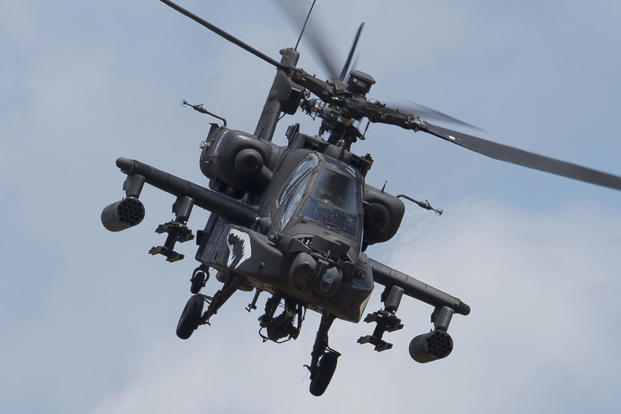National Guard leaders told lawmakers Tuesday that troops supporting the southern border security mission could be more effective at surveillance with the use of more sophisticated aerial platforms such as the AH-64 Apache attack helicopter and the MQ-9 Reaper unmanned aerial system.
Guard pilots have been supporting the U.S. Customs and Border Patrol by flying surveillance missions in the UH-72 Lakota helicopter. Texas and Arizona will soon deploy the RC-26B fixed-wing intelligence, surveillance and reconnaissance aircraft to the border as well.
But Air Force Maj. Gen. Michael McGuire, adjutant general of the Arizona National Guard, told members of the House Homeland Security Committee that other aircraft are available for the mission.
"There are other rotary-wing and remotely piloted systems like MQ-9 and Apache that could be used in night, low-visibility [situations] to help support our customs and border patrol agents out of the normal daytime cycle," he said.
"The problem with MQ-9s is always the confusion about we are not asking to pull people back from theater. We are trying to use assets that we presently use for training with our folks there in garrison to keep their training requirements up," McGuire said. "We could put them on mission on the border just like we are going to do with the RC-26."
It's been more than three months since President Donald Trump tasked the Defense Department to provide increased support of the U.S. border security mission.
Operation Guardian Support authorized the deployment of up to 4,000 National Guardsmen to the southern border to conduct surveillance, logistical support, vehicle maintenance and other support missions to free up border patrol agents to focus on border enforcement.
"Any assistance we can get down on that border helps us," said Rodolfo Karisch, chief patrol agent from the Tucson Sector for the U.S. Border Patrol and Department of Homeland Security.
"I think people seem to look at this as simply an immigration matter, which it's not. You are looking at still a war on terror that we are fighting. You've got guns coming across the border, you've got cash, you've got people and you've got violence. ... Having the support of committed and dedicated National Guardsmen gives our agents much needed help," he said.
Karisch credited the Guard's aviation support with the confiscation of 11,000 pounds of marijuana, as well as assisting with more than 11,000 apprehensions.
But Karisch stressed that Guard personnel are not doing any direct law enforcement work and have no contact with individuals crossing the border into the United States.
"These are the Guard personnel who are either operating aircraft and are making personal observations or working camera rooms," he said. "There was a Raven aircraft unit from the Guard that was flying recently from Tucson, observed six individuals with burlap backpacks, directed agents in, and our agents were able to seize 284 pounds of marijuana and arrested all six individuals."
Rep. Martha McSally, R-Arizona, asked if Guard personnel are getting training opportunities from the border mission.
"Our Lakota pilots are getting real-world training," said Maj. Gen. John Nichols, adjutant general of the Texas National Guard. "It's on-the-spot ... so it's better training than they can do at home."
McGuire agreed. "The pilots get great opportunity to operate the [Lakota] sensor package at night and low-visibility doing real missions," he said.
-- Matthew Cox can be reached at matthew.cox@military.com.















